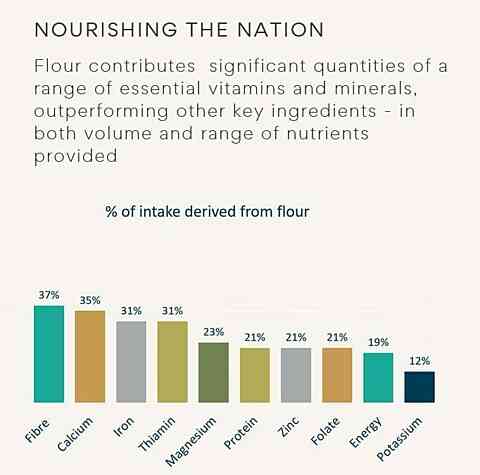What the association does
The industry plays a vital role in feeding and nourishing the nation in terms of the quantity and range of the foods produced with flour, and also the significant nutritional contribution provided by foods made with flour. 12,000 product lines in a typical full service supermarket would contain flour - the table below shows what percentage of food items in certain categories contain flour. The second table shows what percentage of each nutrient is, on average, derived from eating flour. Ensuring that the industry operates efficiently and reliably is therefore of crucial national importance and UK Flour Millers is proud of the part it plays in achieving this outcome.

As a trade association, UK Flour Millers sits at the heart of the industry. Our role as a representative body for the industry includes collating and sharing the collective view and position of our members. As the industry voice we speak on behalf of our members to government, policy makers, the media and other stakeholders. This covers representation on trade issues, including trade relations with other countries, the EU, Canada, USA; work to help secure the supply of competitively priced raw materials for our customers and consumers; help for our members on analysis and technical standards when these are best dealt with collectively; representation on industry bodies such as AHDB and Red Tractor Boards. We also deliver bespoke training programmes for the industry and work to ensure the highest standards of health and safety.
Industry events
UK Flour Millers regularly hosts industry events to bolster the industry, highlighting millers' important work to the right audience at the right time. From hosting R&D Seminars with academics to Fibre February educational brunches with journalists and social media influencers to policy-focused events with Members of Parliament, there are plenty of ways we are connecting with key stakeholders.
Other notable events:
- Conventions: UK Flour Millers hosts biennial conventions in locations throughout the UK; the multi-day event includes an annual general meeting, Executive Committee meeting, full-day conference, welcome reception, and gala dinner, along with an optional day with fun activities pre-planned. On the other years, UK Flour Millers and our members attends European Flour Millers' biennial conferences
- Parliamentary events: meeting these key stakeholders where they already are, events hosted at parliament promote the industry with policymakers, including those with mills directly within their constituency
- Research and Development Seminars: a highly attended event hosted in our office, this forward-looking event brings together key stakeholders from academia, civil service, government, industry players, members, and associate members with the goal of continuing to modernise the sector
- Development Group meetings: formerly young millers, this group comes together to better understand the future of the industry while looking beyond flour milling and at adjacent sectors like logistics, farming, and much more beyond
- Training programme ceremonies: to recognise the efforts of some of the top UK-based Distance Learning Programme and Advanced Milling Diploma students, organisations and select students join key stakeholders
- Committee meetings: related to their areas of expertise, members attend committee meetings to discuss UK Flour Millers and industry activities, initiatives, goals, and much more beyond
- Webinars: these online sessions are held throughout the year with our members and associate members in attendance. There are a range of topics including: market development, sustainability, consumer trends, and much more beyond

Trade policy
A major component of the Association's work is to ensure that high standards are developed and maintained, and that legislation both reflects these high standards and is practicably applicable. This enables our industry to best serve the needs of our customers who use flour to make other foodstuffs and ultimately people who eat them.
Engagement with policy makers
The last several years have seen success following lobbying of the European Commission on its proposals for maximum levels for ergot and ergot alkaloids in cereals and cereals products. A revised version of the proposal was published in 2019.
Other current maximum residue limits (MRL) discussions that the Association is involved in include T2-HT2, deoxynivalenol (DON) and residues of chlorate in food.
We recently collected and shared data on inadvertent presence of allergens (such as soy or mustard) with the Food Standards Agency to help inform their decision on levels of tolerance.
The Association set up a working group to examine existing flour fortification practices, testing and composition and is sharing findings with Public Health England.
Flour microbiology
Since 1971, UK Flour Millers has commissioned an annual, independent survey into the microbial content of flour milled in the UK.
